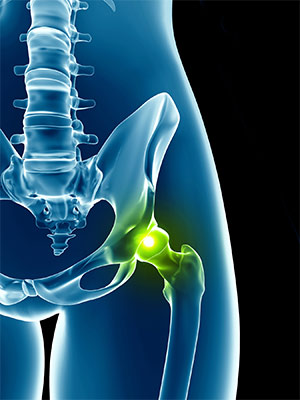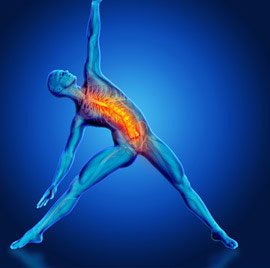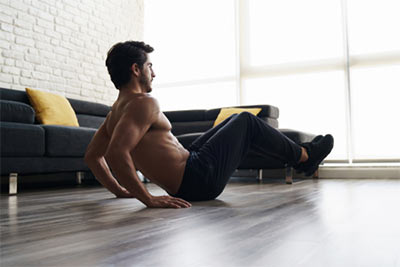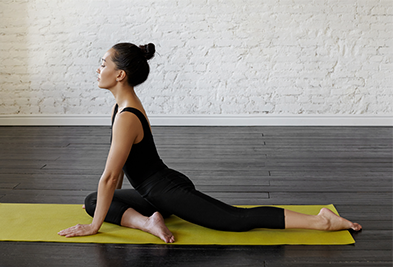
In some ways, the hips are similar to the shoulder in their problems, while in other regards they’re very different.
Today, we’re going to look at the hips and how you need to think about them, how you should be training them, and why all of this is crucially important for your own health, as well as any exercise or sports performance you’re chasing.
Physical Characteristics
The hips are a ball joint with a large ROM, though not as much as the shoulders. The pelvis covers more of the ball joint, offering some more support, but the hip has the same main functions that we see with the shoulder:
- Extension and flexion
- Abduction and adduction
- Internal and external rotation
These require the same level of concern and care that we associate with the shoulder. In this increased range, you need to be more vigilant for the amount of range you’re using, as well as how you’re using it.
The combination of these 3 different types of movement on the hip joint means that there is a lot of scope for moving poorly. On top of these standard ball joint issues, the hips are crucially different from the shoulders; the hips are constantly loaded.
This is important because the hips, their posture, mobility, and control, are all going to be put under the pressure of carrying your weight. This means that issues here are more consequential than, for example, the shoulder, because simple activities like walking and sitting are more demanding on the hip than shoulder.
The hip is even more important for what it affects. The hip is the connecting feature between the spine and the knees. These are two of the most commonly injured joints and they’re the crucial joints in almost every sport; from running to lifting.
When we consider the crucial role that hips play in the body, both in terms of their range, loading, and relation to the knees and spine, it’s clear that developing a hip that is strong and controlled in 3 dimensions is absolutely crucial.

Relevance
When the hip isn’t strong, mobile, and stable in 3 dimensions, we see issues arise in the knees, hips, and spine. Injuries here are some of the most common and debilitating, from athletes to the elderly.
If you get a significant injury in any of these areas, you know you’re in for some discomfort and significant limitations on what you can do. These aren’t just sports, however, but also things like walking, sitting, and bending over.
This isn’t helped by the fact that, for most people, these issues will not clear up quickly. Hip movement also overlaps with almost any measure of performance you’re working on, whether it’s organized sports, gym training, or just recreational activities.
The hips are the powerhouse of the body and produce enormous amounts of force, so when they’re out of position those factors are compromised.
The hips are also absolutely essential in healthy posture; they control the position of the spine, and problems here quickly develop into clinical/medical problems. Issues like lower back pain and hip impingements abound, and these can easily reduce quality of life.
You’re going to use your hips, they’re rarely unloaded, and the way you use them is crucial. Developing a healthy, strong 3D hip allows you to deal with these inevitable challenges as best possible.

Defining The 3D Hip
Strength and mobility in 3 dimensions requires undoing some bad habits. For most of us the eternal process of mobility, control, and strength is still relevant here.
There are a few essentials for better hip health, strength and performance that we’re going to look at. These cover the essentials, and; will all play into the most important mobility and strength exercises you should be using in your day-to-day life.
We’re going to look at the muscle groups that attach to the hips and make them so important…
Establishing Balance: Common Problems and Strengthening Weak/ Loosening
As with other areas of the body, dysfunction in the hip tends to come in the form of a pair of muscles on opposite sides (antagonists); a weak muscle group and a tight group.
As with the 3d shoulder, the idea is to make sure they’re both strong and mobile, but this will usually focus on loosening tight muscles and strengthening weak ones. It’s possible they’re both tight and weak, but we tend to see weakness in the extensors and tightness in the flexors of the hip, for example.
You can get the most benefit in the least amount of time by focusing on these pairings: prioritizing the strengthening of one side and the mobilizing of the other. Ultimately, good exercise choices for the hips will strengthen and mobilize both, but you need to start with what is most efficient and effective.
Hip Extensors
Building mobility in this range is crucial: the extension of the hip is an important part of good posture and performance. This is also the kind of movement skill that we lose with excessive sitting and inactivity; one of the key factors in postural risk, over the long-term, too!
Building mobility for hip extension involves loosening tight hip flexors and moving through full range.
Kneeling lunge stretches and couch stretches are the key to improving the position of the hips, but make sure you’re keeping your core tight and active throughout to avoid over-compensating in the lower back.
Strengthening hip extensors happens in the glutes and hamstrings; the key muscles of the “posterior chain.”

Glutes are developed through thrusting and hinging, while they also work to stabilize the hips and spine during other movements like lunges and squats. Hamstrings are also involved in hinging, where they help extend the hips and thus need to be both mobile and strong.
Stretching these muscles out and getting more comfortable with end ranges will involve lots of hamstring stretching and toe-touch style movements. However, mobility is usually secondary to strength in the glutes, and develops with effective movement.
Movements like glute bridges, Romanian deadlifts, and Jefferson curls are all great ways of building strength and stability in the hip extensors. Remember: it’s all about building strength in the whole range, so focus on movement-length and stability before worrying about weight.

Hip Flexors
The hip flexors are often tight and weak. The job is to get them moving again and then develop control and strength in them. This begins with simple stretching movements like the kneeling lunges, which are paired with hip extension.
Flexion should be trained through core exercises like the lying knee tuck/ leg raise. Movements with deep knee and hip bending like the lunge, squat, and Cossack squat should also be used to train mobility and control.
You can train strength in the hip flexors with exercises like mountain climbers and leg raises/ knee tucks to build strength
It’s also important to work on extension-flexion co-contraction in exercises like the squat and lunge (and pause variations), helping to get both sides of the hips into the movement for better control and stability!

Hip Rotation
Rotating from the hip is actually rotating the femur, but the movement comes from the hip musculature. This is an important factor for performance, primarily in how we train movements like deadlifts, squats, and lunges.
The rotation of the hip is crucial because it allows you to align the knee and foot, which is important for handling weight without causing knee injury. This is also tied into stabilizing the spine and moving through a hip hinge movement effectively, which is a crucial movement skill.
Mobility in these ranges comes from movements like the pigeon stretch and 90/90 position, but will primarily be developed through movement and exercise. Cossack squats, especially supported, and other lateral movements can be really effective in opening up these positions and helping rotation in both directions.
Equally, you can work through movements like banded clams, banded walks (with the knees outside of the feet), banded RDLs, and other targeted rotation exercises. These can be light, but rotational exercises are often about stabilizing the knees and avoiding excessive movement, or resisting the urge to let the knees collapse inwards (valgus).
You can make many other exercises challenging on internal/external rotation by distraction bands, too, like in the lunge with a lateral band.

Abduction and Adduction
Abduction and adduction are often overlooked, but are crucial for stabilizing both the hip and knee. Weakness or tightness here can show up in a number of problems, including hip shifting, knee pain, or reduced mobility in the lateral plane.
Stretching the adductors is common; anything with a straddle or a side lunge is going to start loosening up these overlooked muscles. They’re very tight for most people, due to being completely inactive during sitting, driving, and even some exercises.
Side lunges are great for strengthening and mobilizing these regions, but you should also look at targeted abduction and adduction exercises with a band. Paused versions of these exercises are great for building stability and familiarity, keeping the joints of the hip and knee safe.
Unilateral exercises are going to be the key to strengthening these muscles; they’re going to be crucial in stabilizing during lunges, step-ups, and other movements where the legs move independently. They play a stabilizing role in these exercises, so make sure you’re getting asymmetrical in your own workouts from time to time!
Relation To The Spine
We’ve discussed the hip-spine position before, but it’s so important to hip training; you need to learn to move the two as a single movement in heavier lifts. The movement of the hips and torso simultaneously, rather than moving relative to each other, is key for basic strength and safety.
The hip hinge is the most obvious and important example, where the hips and core stay locked together and never move out of alignment, and is crucial to train. Again, RDLs are a great choice, and especially with a band to drill proper external rotation.
The idea is to keep the hip-trunk unit stable during movements like lunges, squats, deadlifts, and anything else involving the lower body. This is more difficult, but will force you to use the stabilizing muscles of the core and hips that we’ve outlined above.
The hips only go bad when they’re not used properly, and practicing this kind of solid, integrated hip movement is how you turn it all back on!

Final Thoughts
The hips are the central concern for most people when it comes to shoring up their musculoskeletal health, and a key part of sports performance.
Whatever your health and fitness goals, there’s never a bad time to have healthier hips. The solution to building a 3D hip is simply to understand how your hips work, what they have evolved to do, and performing the simple mobility and control/strength exercises outlined in this piece.
It’s not a complicated process, but it does take time, and some of the problems it addresses took decades to build up. It’s not going to happen overnight, but moving your hips properly can start showing significant positive change in a very short space of time.
There are very few benefits to training that compare to the wealth of changes 3d hips will make. It’s a small investment in an enormous long-term pay off.







